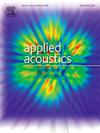低频定向弯张换能器振动分析与优化设计
IF 3.4
2区 物理与天体物理
Q1 ACOUSTICS
引用次数: 0
摘要
弯张换能器的尺寸比波长小得多,这阻碍了紧凑的水声换能器产生定向波束的能力。本文提出了一种利用单路振荡器驱动球面凹凸复合壳体实现低频定向发射的定向弯曲换能器。与传统的使用声挡板或需要调幅调相的多路驱动方法相比,本文设计的换能器只需要一组匹配的功率放大器,既降低了成本,又减少了安装空间。为了更好地阐明低频定向弯张换能器的工作原理,指导该类换能器的设计,建立了低频定向弯张换能器振动的数学模型(MM),并给出了精确解。这样可以精确控制换能器的第一和第二模式,使单极子和偶极子模式的叠加形成指向性。结合有限元模型对换能器进行了优化设计,并制作了换能器样机。MM、FEM和实验(EXP)结果具有良好的一致性,验证了设计的可靠性。所制备的换能器原型在ka <;1. 这为低频水声定向传输提供了一种更为方便的方法。本文章由计算机程序翻译,如有差异,请以英文原文为准。
Vibration analysis and optimization design of the low frequency directional flextensional transducer
The size of a flextensional transducer is much smaller than the wavelength, which hinders the ability of compact underwater acoustic transducers to generate directional beams. This paper proposes a directional flextensional transducer that achieves low-frequency directional emission using a single-circuit oscillator driven a spherical concave-convex composite shell. Compared to the traditional methods of using acoustic baffles or the multi-circuit driving that requires amplitude and phase modulation, the transducer designed in this paper only requires a single set of matched power amplifiers, which reduces both cost and installation space. In order to better elucidate the operating principles of low-frequency directional flextensional transducers and guide the design of such transducers, a mathematical model (MM) of the transducer’s vibration is established, and exact solutions are provided. This allows for precise control of the first and second modes of the transducer, enabling the superposition of monopole and dipole modes to form directivity. An optimized design of the transducer is carried out in conjunction with finite element model (FEM), and a prototype transducer is fabricated. The MM, FEM, and experimental (EXP) results exhibit good consistency, verifying the reliability of the design. The fabricated transducer prototype can generate a cardioid directional beam with a back-radiation suppression of up to −9.5 dB in the low-frequency range where ka < 1. This provides a more convenient method for low-frequency underwater acoustic directional transmission.
求助全文
通过发布文献求助,成功后即可免费获取论文全文。
去求助
来源期刊

Applied Acoustics
物理-声学
CiteScore
7.40
自引率
11.80%
发文量
618
审稿时长
7.5 months
期刊介绍:
Since its launch in 1968, Applied Acoustics has been publishing high quality research papers providing state-of-the-art coverage of research findings for engineers and scientists involved in applications of acoustics in the widest sense.
Applied Acoustics looks not only at recent developments in the understanding of acoustics but also at ways of exploiting that understanding. The Journal aims to encourage the exchange of practical experience through publication and in so doing creates a fund of technological information that can be used for solving related problems. The presentation of information in graphical or tabular form is especially encouraged. If a report of a mathematical development is a necessary part of a paper it is important to ensure that it is there only as an integral part of a practical solution to a problem and is supported by data. Applied Acoustics encourages the exchange of practical experience in the following ways: • Complete Papers • Short Technical Notes • Review Articles; and thereby provides a wealth of technological information that can be used to solve related problems.
Manuscripts that address all fields of applications of acoustics ranging from medicine and NDT to the environment and buildings are welcome.
 求助内容:
求助内容: 应助结果提醒方式:
应助结果提醒方式:


